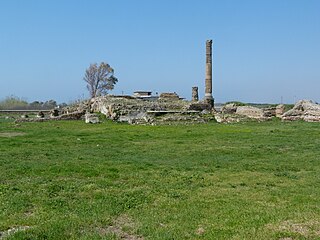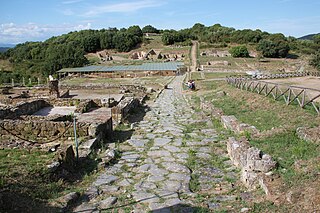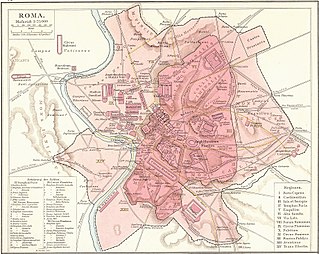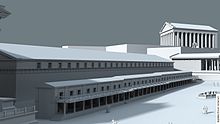
Ephesus was a city in ancient Greece on the coast of Ionia, 3 kilometres (1.9 mi) southwest of present-day Selçuk in İzmir Province, Turkey. It was built in the 10th century BC on the site of the former Arzawan capital by Attic and Ionian Greek colonists. During the Classical Greek era, it was one of twelve cities that were members of the Ionian League. The city came under the control of the Roman Republic in 129 BC.

Ancient Roman architecture adopted the external language of classical Greek architecture for the purposes of the ancient Romans, but was different from Greek buildings, becoming a new architectural style. The two styles are often considered one body of classical architecture. Roman architecture flourished in the Roman Republic and to even a greater extent under the Empire, when the great majority of surviving buildings were constructed. It used new materials, particularly Roman concrete, and newer technologies such as the arch and the dome to make buildings that were typically strong and well-engineered. Large numbers remain in some form across the empire, sometimes complete and still in use to this day.

In Ancient Roman architecture, a basilica is a large public building with multiple functions, typically built alongside the town's forum. The basilica was in the Latin West equivalent to a stoa in the Greek East. The building gave its name to the architectural form of the basilica.

The Roman Forum, also known by its Latin name Forum Romanum, is a rectangular forum (plaza) surrounded by the ruins of several important ancient government buildings at the center of the city of Rome. Citizens of the ancient city referred to this space, originally a marketplace, as the Forum Magnum, or simply the Forum.

Cornelia was the second daughter of Publius Cornelius Scipio Africanus, the hero of the Second Punic War, and Aemilia Paulla. Although drawing similarities to prototypical examples of virtuous Roman women, such as Lucretia, Cornelia puts herself apart from the rest because of her interest in literature, writing, and her investment in the political careers of her sons. She was the mother of the Gracchi brothers, and the mother-in-law of Scipio Aemilianus.

Liternum was an ancient town of Campania, southern central Italy, near "Patria lake", on the low sandy coast between Cumae and the mouth of the Volturnus. It was probably once dependent on Cumae. In 194 BC it became a Roman colony. Although Livy records that the town was unsuccessful, excavation reveals a Roman town existed there until the 4th century AD.

Cosa was a Latin colony founded in southwestern Tuscany in 273 BC, on land confiscated from the Etruscans, to solidify the control of the Romans and offer the Republic a protected port. The Etruscan site may have been where modern Orbetello stands; a fortification wall in polygonal masonry at Orbetello's lagoon may be in phase with the walls of Cosa. The position of Cosa is distinct, rising some 113 metres above sea level and is sited 140 km northwest of Rome on the Tyrrhenian Sea coast, on a hill near the small town of Ansedonia. The town experienced a hard life and was never truly a prosperous Roman city, although it has assumed a position of prominence in Roman archaeology owing to the circumstances of its excavation. After the foundation, wars of the 3rd century BC affected the town. New colonists arrived in 197 BC. Cosa seems to have prospered until it was sacked in the 60s BC, perhaps by pirates - although an earthquake and unrest related to the Catilinarian Conspiracy have also been cited as reasons. This led to a re-foundation under Augustus and then life continued until the 3rd century. One of the last textual references to Cosa comes from the work of Rutilius Claudius Namatianus in his De reditu suo. In the passage 1.285-90, Rutilius remarks that by AD 417 the site of Cosa was deserted and could be seen to be in ruins. He further suggests that a plague of mice had driven the people of Cosa away.

The Basilica Julia was a structure that once stood in the Roman Forum. It was a large, ornate, public building used for meetings and other official business during the Roman Empire. Its ruins have been excavated. What is left from its classical period are mostly foundations, floors, a small back corner wall with a few arches that are part of both the original building and later Imperial reconstructions and a single column from its first building phase.

The Theatre of Pompey was a structure in Ancient Rome built during the latter part of the Roman Republican era by Pompey the Great. Completed in 55 BC, it was the first permanent theatre to be built in Rome. Its ruins are located at Largo di Torre Argentina.

The Temple of Castor and Pollux is an ancient temple in the Roman Forum, Rome, central Italy. It was originally built in gratitude for victory at the Battle of Lake Regillus. Castor and Pollux were the Dioscuri, the "twins" of Gemini, the twin sons of Zeus (Jupiter) and Leda. Their cult came to Rome from Greece via Magna Graecia and the Greek culture of Southern Italy.

Rusellae was an important ancient town of Etruria, which survived until the Middle Ages before being abandoned. The impressive archaeological remains lie near the modern frazione or village of Roselle in the comune of Grosseto.

The Basilica Ulpia was an ancient Roman civic building located in the Forum of Trajan. The Basilica Ulpia separates the temple from the main courtyard in the Forum of Trajan with the Trajan's Column to the northwest. It was named after Roman emperor Trajan whose full name was Marcus Ulpius Traianus.

The Flavian Palace, normally known as the Domus Flavia, is part of the vast Palace of Domitian on the Palatine Hill in Rome. It was completed in 92 AD by Emperor Titus Flavius Domitianus, and attributed to his master architect, Rabirius.

The Temple of Concord in the ancient city of Rome refers to a series of shrines or temples dedicated to the Roman goddess Concordia, and erected at the western end of the Roman Forum. The earliest temple is believed to have been vowed by Marcus Furius Camillus in 367 BC, but it may not have been built until 218 BC by L. Manlius. The temple was rebuilt in 121 BC, and again by the future emperor Tiberius between 7 BC and AD 10.
Tiberius Sempronius Gracchus was a Roman politician and general of the 2nd century BC. He served two consulships, one in 177 and one 163 BC, and was awarded two triumphs. Tiberius is also noteworthy as the father of the two famous 'Gracchi' popularis reformers, Tiberius and Gaius.

Sempronia, was a Roman noblewoman living in the Middle and Late Roman Republic, who was most famous as the sister of the ill-fated Tiberius Gracchus and Gaius Gracchus, and the wife of a Roman general Scipio Aemilianus.

The Curia Julia is the third named curia, or senate house, in the ancient city of Rome. It was built in 44 BC, when Julius Caesar replaced Faustus Cornelius Sulla's reconstructed Curia Cornelia, which itself had replaced the Curia Hostilia. Caesar did so to redesign both spaces within the Comitium and the Roman Forum. The alterations within the Comitium reduced the prominence of the Senate and cleared the original space. The work, however, was interrupted by Caesar's assassination at the Curia of Pompey of the Theatre of Pompey, where the Senate had been meeting temporarily while the work was completed. The project was eventually finished by Caesar's successor, Augustus Caesar, in 29 BC.

The Domus Tiberiana was an Imperial Roman palace in ancient Rome, located on the northwest corner of the Palatine Hill. It probably takes its name from a house built by the Emperor Tiberius, who is known to have lived on the Palatine, though no sources mention his having built a residence. It was enlarged by the successors to Tiberius, and would have been the principal Roman residence of Tiberius, Caligula, Claudius, and Nero during the early part of his reign. Relatively little is known of the structure archaeologically, since the Farnese Gardens have occupied the site of the main level since the 16th century, making excavation difficult.


















